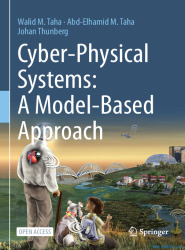Cyber-Physical Systems: A Model-Based Approach
Table of contents
| Pages : | 205 |
| Size : | 4.4 MB |
| File type : | |
| Downloads: | 98 |
| Created: | 2022-02-02 |
| License: | CC BY |
| Author(s): | Walid M. Taha, Abd-Elhamid M. Taha, Johan Thunberg |

Warning: Trying to access array offset on false in /home/tutovnfz/public_html/article.php on line 233
Others model Tutorials
Foundations of Multi-Paradigm Modelling for Cyber-Physical Systems
High-Performance Modelling and Simulation for Big Data Applications
Think Complexity: Complexity Science and Computational Modeling, 2nd Edition
Others related eBooks about Cyber-Physical Systems: A Model-Based Approach
Physical Modeling in MATLABDownload free course Physical Modeling in MATLAB, pdf file on 169 pages by Allen Downey....
A Functional Pattern System for Object-Oriented DesignDownload free course A Functional Pattern System for Object-Oriented Design, pdf file on 346 pages by by Thomas Ku?hne....
Model-Based Engineering of Collaborative Embedded SystemsDownload free course Model-Based Engineering of Collaborative Embedded Systems, pdf file on 411 pages by Wolfgang Böhm, Manfred Broy, Cornel Klein, Klaus Pohl, Bernhard Rumpe, Sebastian Schröck....
The Data Science Design ManualDownload free course The Data Science Design Manual, pdf file on 456 pages by Steven S. Skiena....
Business Models for the Data EconomyDownload free course Business Models for the Data Economy, pdf file on 21 pages by by Q Ethan McCallum, Ken Gleason....
High-Performance Modelling and Simulation for Big Data ApplicationsDownload free course High-Performance Modelling and Simulation for Big Data Applications, pdf file on 364 pages by Joanna Ko?odziej, Horacio González-Vélez....
UML analysis and designUMLTutorial in PDF ,free training document it's an overview of analysis and design using UML ,courses file under 120 pages designated to intermediat-level users....
UML for Java DevelopersThis tutorial is designated to teach the relationship between UML and Java languages to developers in order to make them easily understand the basics of analysis and computer designing,a free training document under 16 pages for download....
Object Modeling with UMLThe purpose of this tutorial is to teach you the UML 2.0 novelties .Download free pdf course on 151 pages for beginners....
Game Design ResearchDownload free course Game Design Research, pdf file on 230 pages by Petri Lankoski, Jussi Holopainen....